Spotting Fens
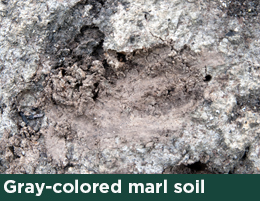 There are a number of types of wetland, including marshes, swamps, bogs, and fens. Each have unique plant communities, different amounts of standing water, and different pH ranges.
There are a number of types of wetland, including marshes, swamps, bogs, and fens. Each have unique plant communities, different amounts of standing water, and different pH ranges.
Fens contain a variety of vegetation, from rushes to sedge-dominated areas with some shrubs. The primary water source is groundwater, and minerals brought in through groundwater both make this an alkaline system and provide more nutrients than bogs receive. Due to the groundwater source, fen soils are water saturated, but rarely have large areas of standing water.
Marshes are either often or continuously inundated with water, meaning they have standing water for much of the year. Vegetation includes soft-stemmed plants that are adapted to saturated soils. The water source is primarily rainwater, but may include groundwater.
Swamps are dominated by shrubs and trees. There are a number of swamp types, but all have soil that is saturated during the growing season and standing water during the wettest parts of the year. The water source is surface runoff and rainwater, and soils are nutrient-rich.
Bogs contain spongy peat covered by a carpet of sphagnum moss. The primary water source is precipitation, and these systems are acidic and nutrient-poor.
Below are several specific clues to look for to determine if you are in an area that is prairie fen, whether it has the species characteristic of a fen or needs management to restore it.
Soils
There are two types of soils that are common in prairie fens, peat, and marl. Peat is a spongy mat that will have some give when walked on or jumped on – it is partially decomposed plant matter built up over thousands of years. Because groundwater brings in mineral deposits through neighboring hillsides that contain sand and gravel deposits left behind by glaciers, fens often also contain marl, formed of light-grey colored calcium carbonate.
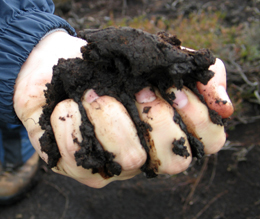
A handful of dark-colored peat soil holds together when squeezed and compresses readily if it is wet. Photo: Andrew Sier, Centre for Ecology & Hydrology, 2004.
Water seeps or springs
These are a characteristic that will persist even if the plants in the fen have changed over time. Water seeps most commonly occur at the base of hillsides, which are composed of glacial deposits. Springs are more likely to be water bubbling up from the soil surface. The soil around springs is usually light-grey colored marl. The water coming from both sources is a constant temperature (between 42 and 55°F), so will feel very cold in summer and warm in winter. These seeps and springs can be most easily located in winter when there is snow cover – their relatively warm temperature will cause an area of melted snow with running water near where the water reaches the soil surface.
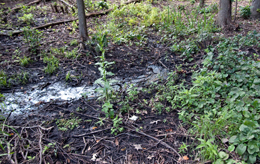
This water seep, like many, appears at the edge of a dry upland area with trees and drains into a wet area with peat soils. This is an area where invasive shrubs were recently removed.
Water levels
Because the main prairie fen water source is groundwater, fens have relatively constant water levels, with water saturated soils. During the wet times of the year they are likely to be wetter than dry times of year, but will not have standing water, or be inundated. Some fens that have grown in with shrubby plants over time, especially invasive shrubs, may have a drier soil surface, so peat soil type then is a better clue than water level.
Hummocks
Prairie fens that are still intact, without non-native invasive species in them, contain characteristic mounds called hummocks. These hummocks support sedges and a wide variety of other plants.
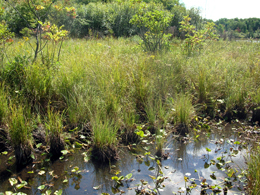
Hummocks.
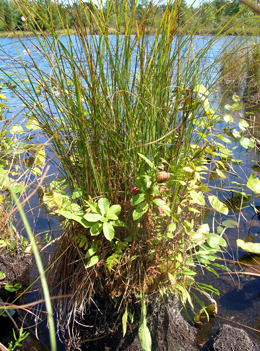
Hummocks.



 Print
Print Email
Email